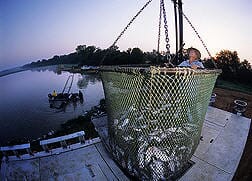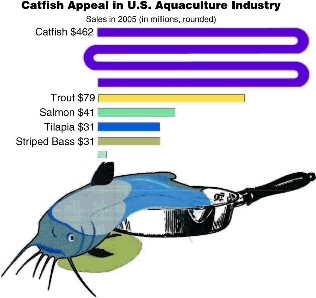 ARS researchers hope that by unlocking the secrets of the catfish genome, commercial catfish producers like this one in Columbus, Mississippi, will be able to increase production levels. |
Commercial catfish production accounts for more than half of U.S. aquaculture production, and the catfish industry is estimated to be worth more than $7 billion, including associated industries such as feed mills, processors, and supply companies.
Researchers in ARS’s Catfish Genetics Research Unit (CGRU) at Stoneville, Mississippi—a state that produces around $245 million worth of catfish each year—are intent on selecting catfish broodstock with superior genetic potential. By unlocking the secrets of the catfish genome, they hope to find favorable natural variations within genes that control important traits such as lean growth, carcass yield, and improved survival in commercial ponds.
At the helm of this project is CGRU molecular biologist Geoff Waldbieser. He, along with geneticist Brian Bosworth and molecular biologists Dan Nonneman and Sylvie Quiniou, has used high-throughput DNA technology to identify more than 40,000 expressed catfish genes and nearly 10,000 variable DNA sequences, termed “microsatellites,” in the catfish genome. Several hundred thousand more catfish DNA sequences will soon be available for public use.
Collaborators in this work are researchers at the University of Mississippi Medical Center in Jackson, Mississippi State University College of Veterinary Medicine, and Auburn University.
When Waldbieser and Bosworth found the first catfish microsatellite sequences, it allowed them to develop a DNA fingerprinting system. That was a crucial first step toward identifying distinct genetic populations—a task that can be difficult because all channel catfish have similar physical characteristics.
By using several selected microsatellites as DNA markers, Waldbieser’s team was able to identify the parents of egg masses, or “spawns,” collected from ponds, and gave CGRU researchers a tool to identify which individual catfish reproduced each year.
“Before then, we only knew that certain broodfish were in the pond, and when we collected the spawns there was no telling who the parents were,” says Waldbieser. “The DNA fingerprints told us that some of the spawns shared the same father. It was the first time we could prove catfish males spawned multiple times in a season.”
The DNA fingerprinting method has become the basis of the U.S. catfish industry’s first strain-certification system, which helps producers maintain the genetic purity of their populations. For example, in 2001 ARS released the fast-growing NWAC103 catfish strain—the first fish germplasm released by the agency—in collaboration with the Mississippi Agricultural and Forestry Experiment Station. Catfish producers can use DNA fingerprinting to avoid mixing NWAC103’s with fish from populations that look similar but don’t grow as quickly.
Waldbieser produced the first catfish genetic map and continues to improve it by adding markers for genes that are the same between catfish and other vertebrates. These markers allow him to integrate the genetic map with the physical genome map that Quiniou has produced. This will permit the CGRU team to compare the catfish genome with the sequenced genomes of other fish or mammals.
Ultimately, the CGRU researchers hope to have a fully sequenced catfish genome that will simplify identification of gene variants found in fish that show improved performance.
By Alfredo Flores, Agricultural Research Service Information Staff.

January 2007

